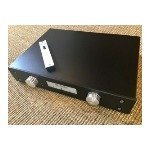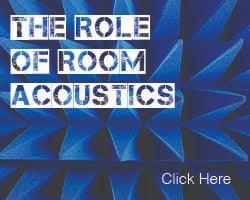A class-T amplifier is a switching Class D amplifier, something I was unaware of until discussing digital amplifiers with a friend a while ago. Class T is the registered trademark for Tripath’s amplifier technologies. Similar designs have now been widely adopted by different manufacturers such as B&O and Hypex and are implemented on many other manufacturers’ amplifier designs such as NuForce, Bel Canto and Jeff Rowland.
It is an implementation of class-D amplifiers, but uses proprietary techniques to control the pulse width modulation to produce what is claimed to be a better performance (eg, lower noise, lower distortion, etc) than other Class D amplifier designs. Among the publicly disclosed differences is real time control of the switching frequency depending on the input signal and amplfied output.
One of the first to become famous designs was the TDA2020 based amplifiers, at their low distortion low output they were predominantly first used in a 5.25″ ATX PC case modular form and were used to power desktop speakers from a computers Soundcard. We see many Tripath based Class T designs on the market nowadays which usually range from anywhere between 10-50 watts per channel but it’s the ‘Class D’ implementations that really hit the big watts with Crown offering 500 watts per channel in their latest power amplifier and other companies touching the 1kw mark.
The control signals in class-T amplifiers may be computed using digital signal processing or fully analog techniques. Currently available implementations use a loop similar to a higher order Delta Sigma (ΔΣ) (or sigma-delta) modulator, with an internal digital clock to control the sample comparator. The two key aspects of this topology are that:
- Feedback is taken directly from the switching node rather than the filtered output.
- The higher order loop provides much higher loop gain at high audio frequencies than would be possible in a conventional single pole amplifier.
Utilising the Tripath TA-2024 and powered externally from am external 12v switch mode power supply the main unit of the Trends 10.2 Class T amplifier remains incredibly small and light, approximately 5cm tall, 8cm wise and 15cm deep including sockets and the Alps volume potentiometer and weighing a meter 300g, the Trends 10.2 can be used literally anywhere a wall socket is available.
From its 10.1 guide the 10.2 shares some of the older units component configuration and some newer updates incorporating the likes of Rubycon caps and the Alps volume pots. The 10.2 also has the ability to be used as a straight power amp bypassing the volume knob altogether by simply moving a set of jumpers on the main board.
Whether in power amp mode or integrated the Trends will output a modest 15 per channel into 4 Ohms and 10 into 8. So it’s intimate near field listening or sensitive speakers which will utilise the 10.2 to its best.
The rear of the 10.2 is also differently layer out to the previous model, the RCAs are centralised now with a set of speaker binding posts either side for easier connection. Power is via a small rear mounted toggle switch.
Trends also supply a linear power supply for $199 which I didn’t receive for this review which would no doubt increase the amps performance, but as I do not have one here I cannot comment.
THE SOUND
Using the Trends 10.2 connected to the analogue output of my Mac Mini via a 3.5mm to twin RCA cable. Playing into some small Mission bookshelves on my desk and after a suitable burn in period I was satisfied by the sound of the little T amp. The tonality is more towards a typical A/B amp rather than a Class D amplifier sounding a touch warmer than the latter.
Interestingly enough vocals when played at reasonable levels gave a sonic presence which was pleasing to the ear and a little more natural and textured than what I believed possible from this minuet metal box. Bass extension too wasn’t exactly deep and extended although it did produce good punch and presence allowing for more energetic pieces of music to deliver some good confident and authorative bass.
I started to believe that the Trends had a bit of a hump in the lower mid upper bass region which needing freeing up, on closer inspection bringing the speakers a little further away from the front wall and popping them on slightly taller myrtle wood feet cleaned this up and I believe that the resonances of the alcove where my desk lives was the guilty party in this instance, I usually use a 2.1 system for the screen here as I can tailor the bass to suit and keep it separated from the upper area of the desk allowing for the satellites to breath freer.
90 degrees to the desk is a sideboard in free space, I set the system up there and still using the Mac as a source directly I compared the previous listening tests. In the freer space the system sounded far more open and transparent and it was nice to here the little 10.2 begin to soundstage with finer details outside of the speaker boundaries. The overall sound was tighter, brighter and punchier. Proving the positives of my desktop listening to grow.
At the time of my perceived issue with the lower mids I was listening to some male vocals which sounded somewhat choked up, now they were running a little lean so I took the glass off of the sideboard and allowed the speakers to sit directly on the wooden top with their rubber feet. This was much more pleasing to my ear and struck a good balance. Who said that even budget gear can’t be tailored with small isolation tweaks?!
I’m not going to allow the Trends 10.2 loose on my reference system as I honestly don’t see the point and I do have an issue with low powered amps on speakers that aren’t quite as efficient as necessary due to clipping and my tweeters aren’t exactly cheap, but from what I’ve heard from a simple computer based analogue output I assumed there was maybe a little more to come from this amp.
Adding a comparably budget Fiio dac from the Mac gave the little T some better layering properties and more midrange transparency. Smaller finer details were more discernible and bass speed seemed to increase whilst still remaining as weighty and taught as previously. I would have liked to sample Trwnds’ own power supply with this amp as I am a big champion of everything should have good clean power else what’s the point of creating a good clean circuit. I have many power supplies and upgraded components but placing one of my own on the 10.2 would also not make sense as it simply wouldn’t be relative.
CONCLUSION
Maximising space, simple to use and enjoyable to listen to the Trends 10.2 Class T Amplifier is a clear step above the run of the mill £30-£50 auction site jobbies. The Trends has a more complex detailed sound and quick nature when fed by something equivalent on a budget scale. Pop a laptop or iPod dock along side and a fairly sensitive set of speakers and the Trends will enjoy itself pleasing you with its eagerness to convey music.
Build Quality: 7.6
Sound Quality: 7.5
Value For Money: 7.3
Overall: 7.46
Dan Worth



































































































































































































You must be logged in to leave a reply.